|
|
|
|
 |
RODENTS: Mountain Beavers |
|
|
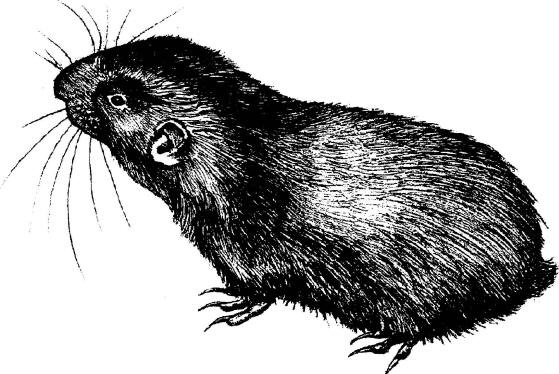
Fig. 1. Mountain beaver,
Aplodontia rufa
Damage
Prevention and Control Methods
-
Exclusion
-
Use plastic mesh
seedling protectors on small tree seedlings. Wire
mesh cages are somewhat effective, but large
diameter cages are expensive and allow animals to
enter them.
-
Exclusion from large
areas with buried fencing is impractical for most
sites.
-
Cultural
Methods/Habitat Modification
-
Plant large tree
seedlings that will tolerate minor damage.
-
Burn or remove slash
to reduce cover.
-
Tractor scarification
of sites will destroy burrow systems.
-
Remove underground
nests to reduce reinvasion.
-
Frightening
-
Not applicable.
-
Repellents
-
36% Big Game Repellent
Powder has been registered for mountain beaver in
Washington and Oregon.
-
Toxicants
-
A pelleted strychnine
alkaloid bait was registered in Oregon but may be
discontinued.
-
Fumigants
-
None are registered.
-
Trapping
-
No. 110 Conibear®
traps placed in main burrows are effective but may
take nontarget animals using burrows, including
predators.
-
Welded-wire,
double-door live traps are effective and selective,
but are primarily useful for research studies and
removal of animals in urban/ residential situations.
-
Shooting
-
Not applicable.
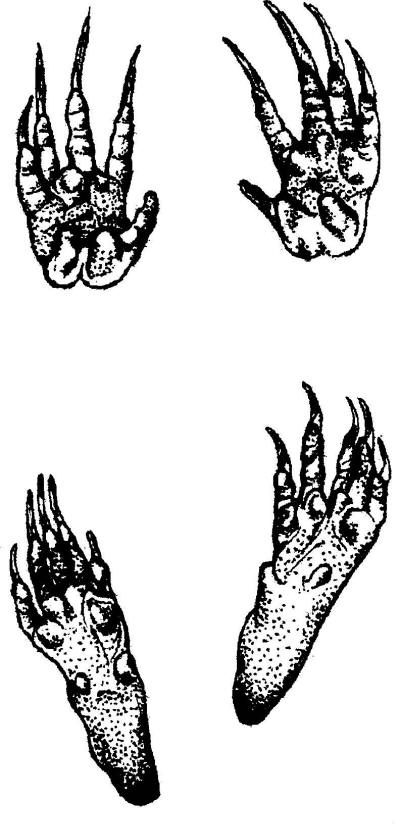 Identification Identification
The mountain beaver (Aplodontia
rufa, Fig. 1) is a medium-sized rodent in the family
Aplodontiadae. There are no other species in the family.
Average adults weigh 2.3 pounds (1,050 g) and range from
1.8 to 3.5 pounds (800 to 1,600 g). Average overall
length is 13.5 inches (34 cm), including a rudimentary
tail about 1 inch (2.5 cm) long. The body is stout and
compact. The head is relatively large and wide and
blends into a large neck with no depression where it
joins the shoulders. The eyes and ears are relatively
small and the cheeks have long silver “whiskers.” The
hind feet are about 2 inches (5 cm) long and slightly
longer than the front feet (Fig. 2). Mountain beavers
often balance on their hind feet while feeding. The
front feet are developed for grasping and climbing.
Adults are grayish brown
or reddish brown. The underfur on the back and sides is
charcoal with brown tips; guard hair is dark brown or
black with silver tips. Ventrally, the underfur is gray
with few guard hairs. A whitish spot of bare skin is
present at the base of the ears. The feet are lightly
furred on top and bare on the soles. Young animals are
generally darker than adults. Males have a baculum (a
bone about 1 inch [2.5 cm] long in the penis). Mature
females generally have a patch of dark-colored underfur
around each of the six nipples.
Fig. 2. Mountain beaver
feet are developed for burrowing and climbing.
Range
Mountain beavers are found
in the Pacific coastal region from southern British
Columbia to northern California (Fig. 3). They range
westward from the Cascade Mountains and southward into
the Sierras. Numbers are higher and populations are more
Mountains and in the coast range of Washington and
Oregon than elsewhere. In the southern limit of its
range, populations are more scattered but sometimes
locally abundant.
Habitat
Mountain beaver habitat is
characteristically dominated by coastal Douglas-fir (Pseudotsuga
menziesii) and western hemlock (Tsuga heterophylla).
Within this zone, mountain beavers often favor moist
ravines and wooded or brushy hillsides or flats that are
not subjected to continuous flooding. Although
frequently found near small streams, they are not
limited to those sites except in more arid regions.
Active burrows may carry water runoff after heavy rains,
but mountain beavers will vacate burrow systems that
become flooded. Mountain beavers do not require free
water; they obtain adequate moisture from the vegetation
they eat.
Mountain beavers occupy
mature forests usually in openings or in thinned stands
where there is substantial vegetation in the understory.
They usually leave stands where the canopy has closed
and ground vegetation has become sparse. Preferred
habitats in forested sites are often dominated by red
alder (Alnus rubra), which the animals promote by
preferentially feeding on conifers and other vegetation.
These sites are often dominated by an understory of
sword fern (Polystichum munitum), a preferred food of
mountain beavers. Stands of bracken fern (Pteridium
aquilinum) are also favored by mountain beavers.
Preferred shrub habitats include salmonberry (Rubus
spectabilis), huckleberry (Vaccinium parvifolium), salal
(Gaultheria shallon), and Oregon grape (Berberis
nervosa). Small trees often found cut by mountain
beavers include vine maple (Acer circinatum) and cascara
(Rhamnus purshiana). These species are often
intermingled with 30 or more other plant species
including forbs, grasses, and sedges.
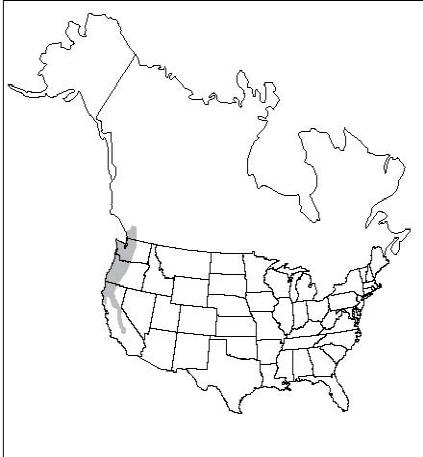
Food Habits
The food habits of
mountain beavers are closely tied to the dominant
vegetation in their habitat. Sword fern and bracken fern
are preferred when available. Douglas-fir, hemlock,
western red cedar (Thuja plicata), and red alder are all
commercial tree species that are cut and eaten by
mountain beavers. Other species found in their habitat
are either eaten or used for construction of nests. Most
feeding occurs above ground within 50 feet (15.2 m) of
burrows, although occasionally mountain beavers may
travel several hundred feet from burrows. They routinely
climb shrubs and trees 8 feet (2.4 m) or higher to cut
off branches up to 3/4 inch (1.9 cm) in diameter, where
they leave cut stubs of branches on trees. Mountain
beavers also girdle the base of tree stems and will feed
on stems up to 6 inches (15 cm) in diameter, as well as
the root systems of large trees. The bark is found in
the stomach contents of animals collected in midwinter.
Woody stems are often girdled and cut into about 6-inch
(15-cm) lengths. Food and/or nest items are often
stacked at burrow entrances (Fig. 4) but are sometimes
carried directly to food caches or nests. Plant material
is occasionally eaten outside the burrow but is usually
eaten at the food cache, in nests, or in the burrow.
Mountain beavers practice coprophagy (consumption of
feces) and select soft over continuous in the coastal
Olympic hard pellets.
Fig. 4. Sword fern and
Douglas-fir piled at the entrance of a mountain beaver
burrow.
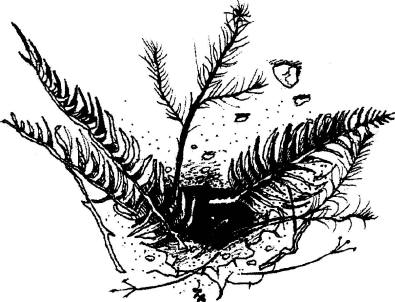 General
Biology, Reproduction, and Behavior General
Biology, Reproduction, and Behavior
Mountain beavers dig
extensive individual burrow systems that generally are
1/2 to 6 feet (0.2 to 1.8 m) deep with 10 to 30 exit or
entrance holes that are usually left open. The ground
surface often caves in where burrows are shallow. There
are many exit burrows forming T-shaped junctions with a
main burrow. These exits may be horizontal or even
vertical. Burrows are often found under old logs and are
sometimes on the surface in logging debris. Mountain
beavers seldom make obvious trails through vegetation.
Most activity is at night and surface travel is usually
near their burrows. Sometimes they are seen during
daylight in dense surface vegetation several feet from
burrow openings. Burrow systems usually cover a 1/4 acre
(0.1 ha) or more and may intersect with burrow systems
of adjacent individuals. Each system is apparently
defended against neighboring mountain beavers. When an
animal leaves a system or dies, the system is often
quickly reoccupied by another mountain beaver.
Fig. 5. Cross section of
part of a mountain beaver burrow system including food
cache, nest, and fecal chamber.
In the spring and summer,
mountain beavers periodically remove molded and
partially eaten vegetation from their food caches. Most
soil excavation occurs during dry periods from spring to
fall. Vegetation is cut year-round, but activity outside
burrows and away from the nest is curtailed during
subfreezing temperatures. Portions of a burrow may not
be used daily, but active burrows in a burrow system are
usually used at least weekly.
The habit of stacking cut
vegetation at burrow openings has been considered a
means to lower its moisture content before taking it
into humid food caches or relatively dry nest chambers.
Mountain beavers, however, do not always stack cut
vegetation and often cut it during periods of continuous
rainfall and high humidity. Occasionally there may be 20
or 30 fern fronds or several tree seedlings stacked at
burrow openings. The animals usually are quick to carry
away small bundles of sword fern that they have placed
inside the burrow opening. Some items such as grasses
and trailing blackberry vines are cut but are seldom
stacked at openings.
Little is known about
mountain beaver behavior during the breeding season.
Breeding activity occurs mainly from January to March
with gestation lasting about 30 days. Young are born
blind and hairless, weighing about 3/4 ounce (20 g).
They develop incisors at about 30 days and are weaned at
about 8 weeks. Young animals are often active in May.
Females apparently do not bear young until 2 years of
age.
Territorial behavior
usually limits mountain beaver population densities to
about 4 per acre (10/ha) although densities may be
higher in some areas. Densities are generally higher in
May and June when young are still active within burrow
systems. In winter, average population densities in
large reforestation tracts (more than 100 acres [40 ha])
seldom exceed 2 animals per acre (5/ha).
Several predators prey on
mountain beavers. Above ground, the main predator, when
present, is probably the bobcat (Felis rufus). Coyotes (Canis
latrans) and great horned owls (Bubo virginianus) are
other major large predators. In burrow systems, mink (Mustela
vison) and long-tailed weasels (Mustela frenata) are the
main predators. Weasel predation is probably limited to
young or subadult animals less able to defend
themselves.
Mountain beavers appear
relatively free of diseases and internal parasites.
Animals in western Washington were checked as possible
carriers of plague but were found negative. A large flea
(Hystrichopsylla schefferi) unique to mountain beavers
is common on the animals but is not known to be a
problem for humans. Mites (Acarina spp.) often infest
the ear and eye region.
Damage and Damage Identification
Mountain beavers have
damaged an estimated 300,000 acres (120,000 ha) of
commercial coniferous tree species in western Washington
and Oregon. Much of the affected land has the potential
to produce timber values of over $10,000 an acre. The
damage period extends to about 20 years after planting.
The major losses occur from cutting tree seedlings
during the first year after planting (Fig. 6). Secondary
damage occurs during the next 5 years to surviving tree
seedlings, followed by stem girdling and root damage for
the next 10 to 20 years. Increased need for weed and
brush control and occasional replanting costs add to the
economic losses caused by mountain beavers.
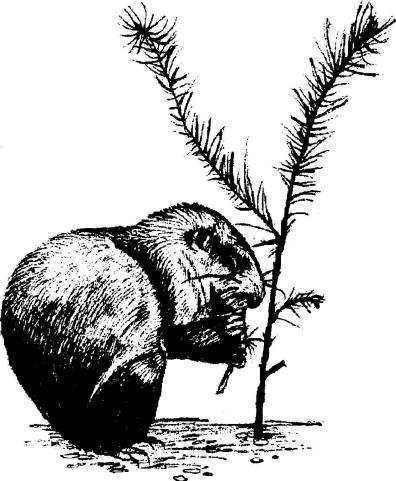 Damage
to conifer seedlings is identified by angular rough cuts
on stems 1/4 to 3/4 inches (0.6 to 1.9 cm) in diameter.
Mountain beavers climb larger trees and cut stems near
the tips. Limbs are often cut a few inches from the
stem. Small trees are usually cut near ground level
while others may be cut several feet up the stem.
Seedling damage occurs primarily in winter and early
spring, but often continues throughout the year. Damage
to conifer seedlings is identified by angular rough cuts
on stems 1/4 to 3/4 inches (0.6 to 1.9 cm) in diameter.
Mountain beavers climb larger trees and cut stems near
the tips. Limbs are often cut a few inches from the
stem. Small trees are usually cut near ground level
while others may be cut several feet up the stem.
Seedling damage occurs primarily in winter and early
spring, but often continues throughout the year.
Fig. 6. Mountain beaver in
feeding position.
Most stem-girdling damage
is at the base of 3- to 6-inch (7- to 15-cm) diameter
stems (Fig. 7). Girdling damage can be distinguished
from that caused by bears or porcupines in that mountain
beavers do not leave pieces of bark scattered on the
ground and they cut the bark smoothly along the edges.
Girdling damage to older stems is more difficult to
distinguish, but it can be verified by examining burrows
near tree trunks where fresh girdling can be seen on the
roots.
Root girdling may occur at
any age, but small roots are usually cut instead of
girdled. Trees with stems over 6 inches (15 cm) in
diameter may die due to extreme root girdling. Root
girdling may allow tree root pathogens to become
established in individual trees and spread to other
trees. It occurs in winter and spring, and may occur in
other seasons.
Fig. 7. Mountain
beaver–girdled conifer tree.
Damage to coniferous
species is considered detrimental to forest production
and can have long-term effects on habitats. This damage
to commercial crops and other vegetation, however, does
provide diversity of cover for other wildlife. In one
area on the Olympic Peninsula in Washington, the
excessive damage to conifers by mountain beavers caused
a manager to change the area designation from
reforestation land to wildlife habitat.
Legal
Status
Fig. 8. Plastic mesh
seedling protector.
Plastic mesh seedling
protectors photodegrade and deteriorate after several
years. Although they expand with stem growth, they
probably provide little protection from girdling of
large diameter stems by mountain beavers.
Wire mesh cages 1 to 3
feet (0.3 to 1 m) in diameter will protect individual
trees but are expensive and may be climbed over and
burrowed under. These cages also allow competing
vegetation to be protected and often cause poor tree
growth. The wire used in these cages may injure tree
growth if cages are tipped or come into contact with the
tree stem.
Cultural Methods
Plant large
tree seedlings to improve survival of the trees in sites
occupied by mountain beavers. Larger stems are less
subject to being clipped at ground level. Although large
seedlings may be seriously damaged, enough foliage often
remains after damage to provide for regrowth and
survival after later damage. Damage-resistant trees
should be about 2 feet (0.6 m) tall and have 1/2-inch
(1.3-cm) or larger diameter stems at the base. Trees
should be planted away from burrow openings so that
mountain beavers will find them less convenient to cut.
Prescribed slash burning
before planting may reduce mountain beaver populations
by reducing available forage and increasing predation.
Extremely hot fires may cause some mortality, but most
mountain beavers will remain protected in their burrows.
Reduction in available forage after fire may cause
mountain beavers to travel farther from burrows and
subject them to higher levels of predation. Legal
restrictions or other practices that inhibit prescribed
burning may favor mountain beaver populations.
Mountain beaver burrow
systems may be destroyed by tractor scarification on
level or moderate slopes when done to remove logging
debris for replanting or to convert brush fields to
plantations. This method requires the use of toothed
land clearing blades to rip soil and destroy burrows. It
seldom removes the deeper nest chambers but can make the
area unattractive to mountain beavers. Avoid piling soil
and wood debris, both of which will attract mountain
beavers. Wood debris piles should be burned when
possible and soil leveled.
Removal of nest chambers
after population reduction will reduce reinvasion of the
burrow systems by 50% or more. Practical methods for
locating and removing nest chambers need further study.
Fig. 9. Application of
powdered repellent to conifer seedling.
Repellents
Coniferous
seedlings subject to mountain beaver damage may be
treated with repellents, but they require special
application procedures to assure the plant stem is
treated near the base (Fig. 9). The effectiveness of a
repellent can be enhanced by conditioning the mountain
beavers to the repellent. Treat cull seedlings with the
same repellent and place them in active burrows. This
practice has caused mountain beavers to avoid both
treated and untreated planted seedlings for up to a year
after planting. The only repellent that has been
registered for mountain beavers in Washington and Oregon
is 36% Big Game Repellent Powder (BGR-P ), originally
registered only for big game. Thiram (tetramethylthiuram
disulfide) is another repellent registered for hares,
rabbits (Sylvilagus spp.), and big game that has been
effective against mountain beavers. Repellents may be of
most value where they cause a long-term avoidance. The
placement of repellent-treated cull tree seedlings in
burrows at time of planting and treating significantly
improves repellent efficacy.
Toxicants
A pelleted
0.31% strychnine bait (Boomer-Rid®) has been registered
in Oregon for control of mountain beavers. Recent field
tests in Washington and Oregon, however, showed marginal
efficacy in late winter with Boomer-Rid®. Pelleted bait
is placed by hand inside main burrows, using about five
baits each in 10 burrow openings in each system. The
registered label allows 1/2 to 1 1/2 pounds of bait per
acre (0.6 to 1.7 kg/ha). The bait formulation contains
waterproofing binders that tolerate wet burrow
conditions.
Experimental zinc
phosphide-treated apple bait was poorly accepted by
mountain beavers and was potentially hazardous to bait
handlers. The treated bait was readily eaten by
black-tailed deer (Odocoileus hemionus columbianus) and
could present a hazard.
Baiting is severely
restricted in areas frequented by endangered species
such as northern spotted owls (Strix occidentalis
caurina), and bald eagles (Haliaeetus leucocephalus).
Fumigants
Fumigants are
generally ineffective because of the open,
well-ventilated structure of the mountain beaver burrow
systems. Aluminum phosphide that was activated when
mountain beavers pulled pellets attached to vegetation
into the nest area was only partially effective. The use
of carbon monoxide gas cartridges and carbon monoxide
gas have been unsuccessful in controlling mountain
beavers. No fumigants are registered for mountain beaver
control. The use of smoke bombs or similar material is
effective in locating the numerous openings in a
mountain beaver burrow system.
Trapping
Mountain
beavers are routinely kill trapped for damage control on
many forest lands scheduled for planting. Trapping is
usually done just prior to planting and repeated 1 or 2
years afterward. Trapping is also repeated when damage
is found in established plantations. Set kill traps in
older stands where stems and roots are being girdled and
undermined. Live trapping is seldom done in forest lands
except for research purposes, but it is used where there
are urban damage problems.
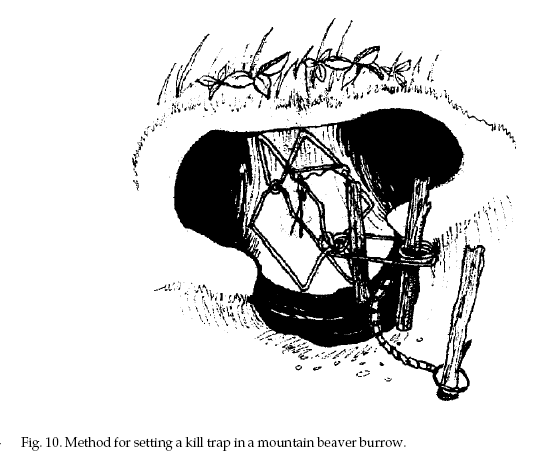
Kill trapping is normally
done using unbaited Conibear® No. 110 traps set in main
burrows. Anchor traps with three sticks, with either two
in the spring (Fig. 10) or with one in the spring and
one at the far end of the jaws, in a vertical position
with the trigger hanging. The trap should take up most
of the space in the burrow, and when properly anchored,
is readily entered by the mountain beavers. This trap is
sometimes not immediately lethal because of the mountain
beaver’s thick short neck. Stronger double-spring traps
may be more effective, but are more difficult to set in
the limited burrow space.
Teams of trappers are
normally used when trapping large acreages. Individual
trappers should be spaced about 30 to 50 feet (9.1 to
15.2 m) apart, depending on habitat conditions. Extra
searching may be required in areas with many small
drainages that may have many burrows. Active burrows
have fresh soil and vegetation piled at burrow entrances
or in burrows. Burrows can often be visually inspected
through openings to determine if there is recent use.
Set two or three traps in each active burrow system. All
trap sites should be marked with flags and mapped so
they may be relocated; a crew of trappers should use
several colors of flagging so that individuals can
relocate their own traplines by color. Trapping in older
stands of conifers can be very difficult because traps
are not easily relocated when branches hide the
flagging. Mapping and flagging travel routes in this
type of habitat may be necessary. The trap lines are
usually checked after 1 day and again checked and pulled
after about 5 days. Traps are usually reset during the
first check even where mountain beavers are captured,
because the systems may be quickly invaded by other
mountain beavers. If trapping is unsuccessful, move
traps to burrows with fresh activity. During the
breeding season (January to March), male mountain
beavers may be more commonly trapped than females
because of their greater activity.
During subfreezing
temperatures, trapping should be postponed or trapping
periods lengthened to include warmer periods when
mountain beavers are more active. Trapping during
periods of snow is also usually less successful than
during snow-free periods because trap sites are
difficult to locate and set, and animals are less
active.
Trapping may take
nontarget species such as weasels, spotted skunks (Spilogale
putorius), mink, squirrels (Tamiasciurus spp.), rabbits,
and hares that use the mountain beaver burrows.
Nontarget losses may be reduced by positioning the trap
trigger near the side of the trap so that it is less
likely to be tripped when small animals pass through.
Live trapping is
recommended where domestic animals may enter the
burrows. Double-door wire mesh live traps such as
Tomahawk traps (6 x 6 x 24 inches [15 x 15 x 61 cm])
should be set nearly level in main burrows. Suitable
vegetation should be placed inside and along the outside
of the trap. Wrap the trap with black plastic and cover
it with soil to protect animals from the weather.
Placement should assure that animals enter rather than
go around the ends of the trap. Traps must be checked
once or twice daily, preferably in early morning and
again in the late afternoon, to minimize injury and
stress to mountain beavers held in the live traps.
Live-captured mountain beavers should be placed in dry
burlap sacks and, if necessary, euthanized with carbon
dioxide.
Shooting
Shooting is not
a practical control method.
Other Methods
Habitat
manipulation by increasing or decreasing favored
vegetation has been evaluated only indirectly. Where
native forbs were seeded to reduce deer damage to
Douglas-fir plantations, mountain beaver damage did not
significantly decrease or increase. In another area,
where red huckleberry was abundant and extensively cut,
mountain beaver damage to Douglas-fir was insignificant.
Economics of Damage and Control
Mountain beavers cause
considerable economic damage to reforestation. Most of
their habitat is in timberland where the potential crop
value is high. Well-stocked stands of Douglas-fir are
usually commercially thinned once or twice before final
harvest, and often produce timber values of thousands of
dollars per acre. When mountain beavers prevent
reforestation or cause expenditures for protecting
reforestation, the value of the crops is reduced or
eliminated. A planned Douglas-fir crop rotation period
of 40 years on good sites can be severely disrupted if
at 15 years the crop is lost to damage by mountain
beavers. Since mountain beaver damage occurs on about
300,000 acres (120,000 ha) of commercial forest land, a
conservative annual loss estimate of $100 per acre
($250/ ha) results in an annual loss of $30 million.
Losses to mountain beavers may be $10,000 per acre
($24,700/ha) when damage causes failure of the timber
crop.
Economic losses are caused
by both direct and indirect damage. Cutting of planted
tree seedlings is the most common damage. If it has been
several years since planting, the site may need brush
control by machine, hand, or herbicide before replanting
can be done. Damage to tree seedlings also keeps the
trees within a size range that is susceptible to damage
by hares, rabbits, deer, and elk. If damage is not
controlled, large areas may not be adequately
reforested. Trees that escape early damage may be
damaged later by girdling and undermining by mountain
beavers, causing a loss of many years’ growth of
commercially valuable species.
The mountain beaver
currently has no commercial value. The pelt has no fur
value and there is no market for the meat. The animal is
of significant zoological and medical interest, however,
because of its limited range and unique physiological
characteristics. Despite its limited range, however, the
overall populations of mountain beavers have probably
increased since timber harvesting began in the Pacific
Northwest.
The burrowing and
vegetation cutting activities of mountain beavers may
improve soils and reduce competition by brush species.
Sometimes, however, the burrowing activity has caused
damage to roads and trails. Forest workers are
periodically injured by falling into mountain beaver
burrows.
An economic study of
Pacific Northwest forest animal damage indicates that
damage control expenditures of about $150 per acre
($375/ha) are reasonable on average-site Douglas-fir
forest land. On higher quality land the expenditure for
damage control can be higher, particularly where
mountain beavers cause heavy mortality in reforestation
areas.
Acknowledgments
I wish to thank numerous
employees of USDAAPHIS, the USDA Forest Service, the
USDI Bureau of Land Management, the Washington
Department of Natural Resources, the Oregon Department
of Forestry, and many private forest industry companies
for support of studies involving research into mountain
beaver damage control. I also wish to thank Kathryn
Campbell for the illustrations drawn from photos and
descriptions by the author.
For Additional Information
Borrecco, J. E. 1976. Vexar tubing as a means to protect
seedlings from wildlife damage. Weyerhaeuser For. Res.
Tech. Rep. 4101/76/36. 18 pp.
Borrecco, J. E., and R. J.
Anderson. 1980. Mountain beaver problems in the forests
of California, Oregon, and Washington. Proc. Vertebr.
Pest Conf. 9:135-142.
Campbell, D. L. 1987.
Potential for aversive conditioning in forest animal
damage control. Pages 117-118 in H. L. Black, ed. Proc.
Symp. Anim. Damage Manage. Pacific Northwest For.
Spokane, Washington.
Campbell, D. L., and J.
Evans. 1975. “Vexar” seedling protectors to reduce
wildlife damage to Douglas-fir. USDI Fish Wildl. Serv.
Wildl. Leaflet. No. 508. 11 pp.
Campbell, D. L. and J.
Evans. 1988. Recent approaches to controlling mountain
beavers (Aplodontia rufa) in Pacific Northwest forests.
Proc. Vertebr. Pest Conf. 13:183-187.
Campbell, D. L., J. Evans,
and G. B. Hartman. 1988. Evaluation of seedling
protection materials in western Oregon. US Dep. Inter.
Bureau Land Manage. Tech. Note OR-5. 14 pp.
Campbell, D. L., J. D.
Ocheltree, and M. G. Carey. 1988. Adaptation of mountain
beaver (Aplodontia rufa) to removal of underground
nests. Northwest Sci. 62(2):75.
Engeman, R. M., D. L.
Campbell, and J. Evans. 1991. An evaluation of two
activity indicators for use in mountain beaver burrow
systems. Wildl. Soc. Bull. 19:413-416.
Evans, J. 1984. Mountain
beaver. Pages 610-611 in P. MacDonald, ed. The
encyclopedia of mammals. Facts on File Publ. New York.
Evans, J. 1987. Mountain
beaver damage and management. Pages 73-74 in H. L.
Black, ed. Proc. Symp. Anim. Damage Manage. Pacific
Northwest For. Spokane, Washington.
Feldhamer, G. A. and J. A.
Rochelle. 1982. Mountain beaver. Pages 167-175 in J. A.
Chapman and G. A. Feldhamer, eds. Wild mammals of North
America: biology, management, and economics. The Johns
Hopkins Univ. Press, Baltimore.
Hartwell, H. D. and L. E.
Johnson. 1992. Mountain beaver tree injuries in relation
to forest regeneration. DNR Res. Rep. State of
Washington, Dept. Nat. Resour. Olympia. 49 pp.
Hooven, E. F. 1977. The
mountain beaver in Oregon: its life history and control.
Res. Pap. 30. Oregon State Univ. Corvallis. 20 pp.
Martin, P. 1971. Movements
and activities of the mountain beaver (Aplodontia rufa).
J. Mammal. 52:717-723.
Motobu, D., J. Todd, and
M. Jones. 1977. Trapping guidelines for mountain beaver,
Weyerhaeuser For. Res. Rep. 042-4101/77/20. 28 pp.
Editors
Scott E. Hygnstrom; Robert
M. Timm; Gary E. Larson
PREVENTION AND CONTROL OF
WILDLIFE DAMAGE — 1994
Cooperative Extension
Division Institute of Agriculture and Natural Resources
University of Nebraska -Lincoln
United States Department
of Agriculture Animal and Plant Health Inspection
Service Animal Damage Control
Great Plains Agricultural
Council Wildlife Committee
05/16/2006
Special
thanks to:
Clemson University
|